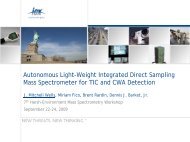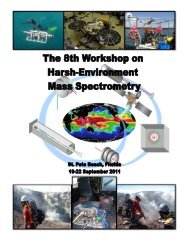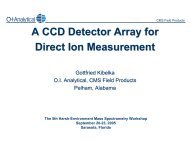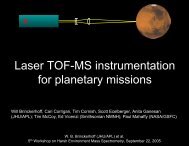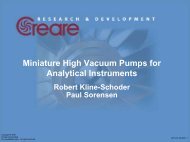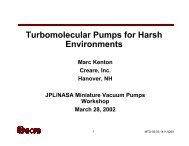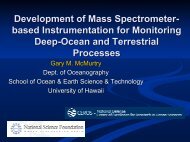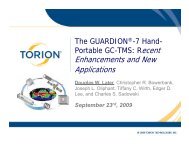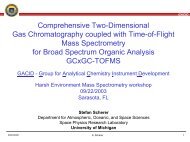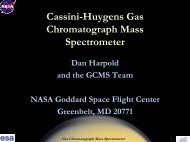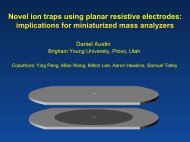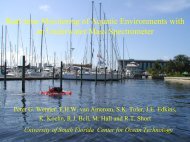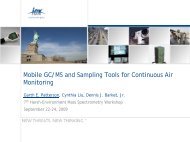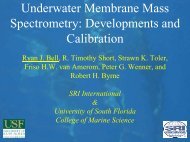Recent Developments with the Rotating Field Mass Spectrometer ...
Recent Developments with the Rotating Field Mass Spectrometer ...
Recent Developments with the Rotating Field Mass Spectrometer ...
You also want an ePaper? Increase the reach of your titles
YUMPU automatically turns print PDFs into web optimized ePapers that Google loves.
<strong>Recent</strong> <strong>Developments</strong> <strong>with</strong> <strong>the</strong> <strong>Rotating</strong> <strong>Field</strong> <strong>Mass</strong><br />
<strong>Spectrometer</strong> (RFMS) and Nanospray Ionizer”<br />
Steven J. Smith<br />
•Jet Propulsion Laboratory, Pasadena CA<br />
Gary McMurtry<br />
SOEST, Univserity of Hawaii, Honolulu HI
Current State-Of-The-Art <strong>Mass</strong> <strong>Spectrometer</strong><br />
Performance Metrics<br />
<strong>Field</strong> Ionization/RFMS Electron-Bombardment Radioactive Ionization<br />
Operating domain Torr - NanoTorr (10 1 :
Schematic of rotating field spectrometer
Active Pixel Detection - Enhanced M/∆M<br />
APS pixel 10 -17 Amps<br />
1024 Pixels<br />
Sub-pixel centroiding and<br />
radial integration will have<br />
sensitivity of < 10 -17 Amps<br />
(channel plate ~10 -19 A)<br />
1024 Pixels
Nanospray Layout
Angiotensin /nanospray
Beckman Coulter -JPL Task<br />
Lysozyme<br />
600<br />
s<br />
t<br />
n<br />
u<br />
o<br />
C<br />
500<br />
400<br />
300<br />
Lysozyme<br />
200<br />
100<br />
0<br />
1000 1500 2000 2500 3000 3500 4000 4500 5000<br />
<strong>Mass</strong> (amu)
Lysozym<br />
e charge state peaks at various mass to charge ratios<br />
100000000<br />
10000000<br />
Charge State +1<br />
100000000<br />
10000000<br />
Charge State +3<br />
100000000<br />
10000000<br />
Charge State +2<br />
Relative Signal<br />
1000000<br />
100000<br />
Relative Signal<br />
1000000<br />
100000<br />
1000000<br />
100000<br />
10000<br />
10000<br />
10000<br />
1000<br />
1000<br />
1000<br />
100<br />
1E-10 1E-9 1E-8 1E-7 1E-6 0.00001 0.0001<br />
Lysozyme Concentration<br />
100<br />
1E-10 1E-9 1E-8 1E-7 1E-6 0.00001 0.0001<br />
Lysozyme Molar Concentration<br />
100<br />
1E-10 1E-9 1E-8 1E-7 1E-6 0.00001 0.0001<br />
Lysozyme Molar Concentration<br />
100000000<br />
100000000<br />
Charge State +6<br />
10000000 Charge State +7<br />
Relative Signal<br />
10000000<br />
1000000<br />
100000<br />
Charge State +5<br />
Relative Signal<br />
10000000<br />
1000000<br />
100000<br />
Relative Number<br />
1000000<br />
100000<br />
10000<br />
10000<br />
10000<br />
1000<br />
1000<br />
1000<br />
100<br />
1E-10 1E-9 1E-8 1E-7 1E-6 0.00001 0.0001<br />
Lysozyme Molar Concentration<br />
100<br />
1E-10 1E-9 1E-8 1E-7 1E-6 0.00001 0.0001<br />
Lysozyme Molar Concentration<br />
100<br />
1E-10 1E-9 1E-8 1E-7 1E-6 0.00001 0.0001<br />
Lysozyme Molar Concentration<br />
Lysozyme in ethanol at 10 -3 -10 -10 Mol range <strong>with</strong> raw signal counts from each of <strong>the</strong> charge peaks
Summary of DNA Samples<br />
<strong>Mass</strong> Analyzied to Date<br />
Sample Types: These have included 10 -4 to 10 -10 molar lysozyme, angiotensin, adenosine, both positive<br />
and negative electrospray of seawater, and most recently, large DNA fragments and 10 micromolar<br />
solutions of oligonucleotides etc. Working <strong>with</strong> samples obtained from <strong>the</strong> CITY of HOPE Medical<br />
Center, courtesy Dr. Ted Krontiris. <strong>the</strong> following DNA samples have been injected into <strong>the</strong> device.<br />
___________________________________________________________________________<br />
Name # length (mer) [ ] micromolar MW<br />
P21E3AS 2 20 10 6173<br />
60P21E3 6 60 10 18283<br />
F-N1C80 7 80 10 24253 + FAM (600) total = 24853<br />
GMS2S2 8 102 4.15 31257<br />
_________________________________________________________________________<br />
High Throughput Genotyping, Microbial and Biological Genotyping.<br />
Some samples to be analyzed would contain mixture of 4-50 polynucleotides closely grouped in size from 20-100<br />
nucleotides (6600-33000 Dalton) and would require 1 nucleotide resolution. In <strong>the</strong> past such analyses have been done<br />
<strong>with</strong> large state of <strong>the</strong> art MALDI-TOF instruments costing $200,000. This compact field instrument could obtain<br />
comparable performance. Multiple RFMS systems could be built and would be ideal in this application since <strong>the</strong> number<br />
of components in <strong>the</strong> mixture can typically be pre-identified, <strong>the</strong> mass values for <strong>the</strong> components of interest are known, and<br />
<strong>the</strong>re is no requirement for MS/MS analysis. The potential exists to develop a low cost system suitable for clinical or<br />
research applications.
60 mer DNA Fragment<br />
Relative Signal<br />
150<br />
100<br />
60 mer DNA Sample 60P21E3<br />
m.w. 18283<br />
+8<br />
+9<br />
+7<br />
+10<br />
+6<br />
+5<br />
50<br />
+11<br />
+4?<br />
+3<br />
+2<br />
0<br />
1000 10000<br />
M/Z<br />
Figure 1 A JPL mass spectrum of <strong>the</strong> 60 mer DNA Shown is <strong>the</strong> various m/z charge<br />
states arising from electrospray ionization. As can be seen, <strong>the</strong> RFMS is capable of<br />
measuring mass over an extremely large dynamic range.
Atmospheric Chemistry by Low<br />
pressure rotating field mass<br />
spectrometry (LP-RFMS)
Low Pressure - <strong>Rotating</strong> <strong>Field</strong> <strong>Mass</strong> <strong>Spectrometer</strong> (LP-RFMS<br />
RF Power<br />
Accelerator Grid<br />
Ionizing membrane<br />
• Unique mass spectrometer consisting of <strong>the</strong> field ionizer array, simple ion beam accelerator and<br />
lens optics, <strong>Rotating</strong> <strong>Field</strong> <strong>Mass</strong> <strong>Spectrometer</strong> (RFMS) and an ion detector<br />
• <strong>Field</strong> ionizer array completely ionizes transit gas:<br />
♦ ionization is ‘soft’ - no species fragmentation<br />
♦ operates under Paschen curve - no plasma breakdown at any gas pressure<br />
♦ ion currents great enough to accommodate beam attenuation at pressures > 7 Torr<br />
♦ operational at both high and cryogenic temperatures<br />
• <strong>Mass</strong> spectrometer has no vacuum pump, no filaments or radio active source<br />
• ‘On resonance’ ions (selected mass/charge) pass through <strong>the</strong> mass spectrometer in well defined<br />
helix trajectories to impinge upon <strong>the</strong> faraday cup ion collector
Confidential<br />
‘Soft’ Ionization Membrane<br />
Avalanche arcing is <strong>the</strong> general out come of gas ionization in a<br />
high electric field. However, when <strong>the</strong> mean free path length<br />
between ionized molecules is greater than electrode separation<br />
– on <strong>the</strong> left of <strong>the</strong> Paschen curve - only ionization occurs.<br />
A miniature ionization device is best realized by micromachining small holes through a thin<br />
(sub-micron) membrane that has metal electrodes on each side of it. Electric field strengths in<br />
<strong>the</strong> megavolts/meter are, at sub-micron electrode separation, generated for each volt of potential<br />
difference between <strong>the</strong> metal electrodes. With electric field strengths in <strong>the</strong> tens to hundreds of<br />
MV/m any gas passing through <strong>the</strong> perforations and thus between <strong>the</strong> electrodes is totally<br />
ionized. Sub-micron thick membranes of moderate area are too fragile to sustain any pressure<br />
difference across <strong>the</strong>m or to survive minor mechanical shock. A 0.1 mm thick substrate backing,<br />
back etched through to membrane,<br />
resolves <strong>the</strong>se problems. The<br />
photographs present a 10x10 matrix CO<br />
of anisotropically etched pits, a single<br />
2<br />
gold plated pit, gold covered<br />
membrane at bottom of pit, and FIB<br />
eroded hole (~2µm dia.) through<br />
300nm Nitride membrane gold<br />
coatings (top and bottom).<br />
pd (mm-mm Hg)<br />
Paschen Curves for Various Gases<br />
Top Metal Coating<br />
Bottom Metal Coating<br />
* Diaphragm<br />
(Insulator)<br />
Ethanol
• Demonstrated mass range from 1 > 360,000 AMU {1200 MER<br />
DNA}<br />
• Sensitivity of > 1 PPB or 10 -11 Molar<br />
• <strong>Mass</strong> resolution <strong>with</strong> cup > 400, <strong>with</strong> probe wire > 1000, and<br />
<strong>with</strong> APS > 10,000 M/∆M<br />
• Accuracy < 1% of reading for PPM and < 5% for PPB<br />
• Electronic sensitivity - channel plate 10 -19 Amps - APS pixel 10 -17<br />
Amps<br />
• No sensitivity drift over time (<strong>with</strong> reference gas sampling or insitu<br />
ratiometric comparisons <strong>with</strong> ‘known’ gas concentrations)<br />
• Temperature range - Dew point (sampling pressure) : 200 o C<br />
• Maximum chamber pressure ~ 35 Torr (5% atmos. @ Sea level)<br />
• Response time (dependant on sampling transport delays) < 60 sec.<br />
• Sensor life expectancy (porous membrane) > 6 months (<strong>with</strong><br />
filters) ce impervious to species complement
FIRMS spectra of Natural Gas & Air
FIRFMS spectra of EPA standard
. . The solid model design and picture of <strong>the</strong> actual <strong>Rotating</strong> <strong>Field</strong> <strong>Mass</strong> <strong>Spectrometer</strong> (SIM/RFMS) are<br />
shown below in Figures 7 and 8 which shows that <strong>the</strong> sensor is small enough to fit in <strong>the</strong> REMUS payload
Trichloroethylene (TCE)<br />
TCE<br />
1x10 +10<br />
1x10 +10<br />
1x10 +10<br />
H 2 O<br />
O 2<br />
TCE<br />
8x10 9<br />
6x10 9<br />
4x10 9<br />
2x10 9<br />
0<br />
0 25 50 75 100 125 150 175 200 225 250<br />
<strong>Mass</strong> amu<br />
Figure 3 – <strong>Mass</strong> spectrum of reagent grade<br />
trichloroethylene.
DMMP Solution<br />
10% Dimethyl Methane Phosopohnate in H 2 O<br />
0.150<br />
H 2 O<br />
C 3 H 9 O 3 P<br />
Current<br />
0.100<br />
0.050<br />
N 2<br />
0.000<br />
20 30 40 50 60 70 80 90100 200 300<br />
<strong>Mass</strong> (amu)
CH 3<br />
P O(OCH 3<br />
) ::: {OCH 3 }<br />
CH 3<br />
(OCH 3<br />
) 2<br />
::: { PO}<br />
CH 3<br />
P (OCH 3<br />
) 2<br />
::: { O}<br />
CH 3<br />
PO(OCH 3<br />
) 2<br />
PO<br />
– NIST mass spectrum of pure DMMP in high vacuum. The<br />
unfragmented peak at 124 amu is smaller than those of many<br />
fragments.
Malathion, With Carbaril, Methoxychlor,Captan, and kerosene binder<br />
0 5 Captan<br />
0 5<br />
0 5<br />
Malathion<br />
Methoychlor<br />
0 5<br />
0 5<br />
Carbaril<br />
0 5<br />
0 4<br />
0<br />
– <strong>Mass</strong> spectrum of “Liquid Fruit Tree Spray” containing neurotoxins which are<br />
readily identified in <strong>the</strong> spectrum.
Photograph of <strong>the</strong> JPL <strong>Rotating</strong> <strong>Field</strong> <strong>Mass</strong> <strong>Spectrometer</strong>, showing major components (labeled)<br />
made primarily of 304 stainless steel and ceramic. Components labeled W are made of tungsten<br />
metal.
RFMS addapted for high g (2400g) impact, <strong>with</strong> glass bead “poweder” support
Sandia High –g Impact
Impact Shell Side View
Plywood Target Stack
RFMS after impact test, removed from glass bead support
Counts (arb. units)<br />
0.070<br />
0.065<br />
Lysozyme in Isopropyl<br />
0.060<br />
0.055<br />
0.050<br />
0.045<br />
0.040<br />
0.035<br />
0.030<br />
0.025<br />
0.020<br />
0.015<br />
0.010<br />
0.005<br />
0.000<br />
1000 10000<br />
<strong>Mass</strong> (amu)<br />
<strong>Mass</strong> Spectra taken <strong>with</strong> RFMS after impact
Seawater Samples, Positve and Negative<br />
Electrospray



